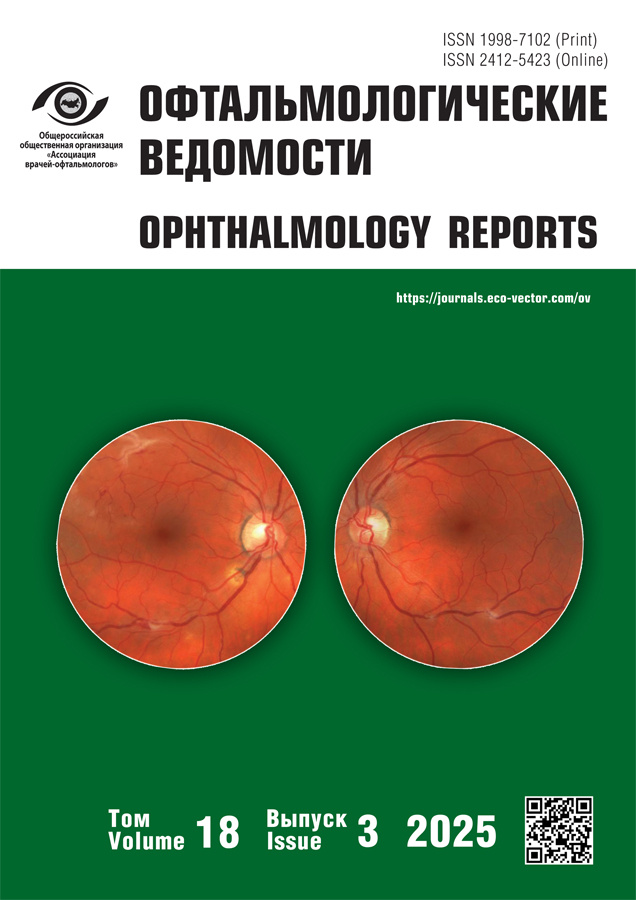Diagnostic criteria for personalized surgical treatment of congenital blepharoptosis in children
- Authors: Ivanova S.P.1, Davydov D.V.2
-
Affiliations:
- S.V. Belyaev Kuzbass Regional Clinical Hospital
- National Medical Research Radiological Center
- Issue: Vol 18, No 3 (2025)
- Pages: 7-15
- Section: Original study articles
- URL: https://bakhtiniada.ru/ov/article/view/349521
- DOI: https://doi.org/10.17816/OV679587
- EDN: https://elibrary.ru/TTIBTT
- ID: 349521
Cite item
Abstract
BACKGROUND: Blepharoptosis is the most common congenital disorder of the upper lid position manifested as drooping. Treatment of this condition is surgical. However, despite the development of many preoperative diagnostic criteria for choosing surgical strategy, to date, no single set of pre-, intra-, and postoperative diagnostic criteria has been developed to achieve sustained, intended, functional, and esthetic outcomes.
AIM: The study aimed to evaluate the effect of preoperative diagnostic criteria on selection of surgical strategy and to analyze surgical outcomes.
METHODS: The study was conducted from 2019 to 2024 and included 116 naive children diagnosed with congenital blepharoptosis. The patients were divided into two treatment groups, and different sets of diagnostic preoperative criteria for choosing surgical strategy were used in both of them. Surgical procedures included resection of the upper lid levator or superior tarsal muscle. Intraoperative diagnostic criteria were additionally applied in group 2. Postoperatively, patients were followed-up on days 1, 3, and 7 and at months 1, 3, and 6 to evaluate the surgical outcomes.
RESULTS: Undercorrection in 13 (33.33%) patients required re-intervention in group 1 (n = 39), where the diagnostic preoperative examination included 5 criteria. In the late postoperative period (over 6 months), persistent mild lagophthalmos was observed in 7 (17.95%) patients. For group 2 (n = 77), the preoperative diagnostic examination included 12 criteria, and intraoperative diagnostic criteria were also applied. A total of 16 (20.78%) patients required re-intervention, and postoperative persistent mild lagophthalmos was reported in 1 (1.3%) patient. The study demonstrated 12.55% decrease in re-interventions and 16.65% decrease in a postoperative complication of persistent lagophthalmos.
CONCLUSION: Additional criteria for preoperative examination allowed considering the anatomical and physiological characteristics of children with congenital blepharoptosis to choose surgical strategy, and intraoperative diagnostic criteria provided intended, sustained, functional, and esthetic outcomes.
Full Text
##article.viewOnOriginalSite##About the authors
Sofia P. Ivanova
S.V. Belyaev Kuzbass Regional Clinical Hospital
Author for correspondence.
Email: sofaivanova613@gmail.com
ORCID iD: 0000-0002-4131-6349
SPIN-code: 6752-3373
MD
Russian Federation, KemerovoDmitry V. Davydov
National Medical Research Radiological Center
Email: d-davydov3@yandex.ru
ORCID iD: 0000-0002-8025-4830
SPIN-code: 1368-2453
P. Hertsen Moscow Oncology Research Institute, MD, Dr. Sci. (Medicine), Professor
Russian Federation, MoscowReferences
- Griepentrog GJ, Diehl NN, Mohney BG. Incidence and demographics of childhood ptosis. Ophthalmology. 2011;118(6):1180–1183. doi: 10.1016/j.ophtha.2010.10.026
- Stein A, Kelly JP, Weiss AH. Congenital eyelid ptosis: onset and prevalence of amblyopia, associations with systemic disorders, and treatment outcomes. J Pediatr. 2014;165(4):820–824.e2. doi: 10.1016/j.jpeds.2014.06.053
- Anderson RL, Baumgartner SA. Amblyopia in ptosis. JAMA Ophthalmol. 1980;98(6):1068–1069. doi: 10.1001/archopht.1980.01020031058009
- Efimova EL. Visual impairment in children with congenital blepharoptosis. Modern technologies in ophthalmology. 2020;35(4):209–210. doi: 10.25276/2312-4911-2020-4-209-210 EDN: SFLBIB
- Afanasyeva PS. Frequency of occurrence of ametropia, impaired eyeball mobility and amblyopia in children with congenital ptosis. Forcipe. 2020;3(S1):630. (In Russ.) EDN: DFFGKR
- Wang Y, Xu Y, Liu X, et al. Amblyopia, strabismus and refractive errors in congenital ptosis: a systematic review and meta-analysis. Sci Rep. 2018;8(1):8320. doi: 10.1038/s41598-018-26671-3
- Kataev MG. Modern differentiated approach to surgical treatment of upper eyelid ptosis. Point of view. East – West. 2014;(1):258–259. (In Russ.) EDN: TAGWAH
- Clauser L, Tieghi R, Galiè M. Palpebral ptosis: clinical classification, differential diagnosis, and surgical guidelines: an overview. J Craniofac Surg. 2006;17(2):246–254. doi: 10.1097/00001665-200603000-00008
- Berke RN. Congenital ptosis; a classification of 200 cases. JAMA Ophthalmol. 1949;41(2):188–197. doi: 10.1001/archopht.1949.00900040193006
- Aznabaev MT, Ishbulatov RS. Suspension operations for blepharoptosis. In: Current issues in pediatric ophthalmology. Ufa; 1988. P. 10–13. (In Russ.)
- Krasnov MM, Grusha YaO, Fedorov AA, et al. Possibilities of the muellerectomy operation in the correction of upper eyelid ptosis. Russian annals of ophthalmology. 2002;118(1):9–12. (In Russ.) EDN: TDLAPL
- Gushchina MB, Egorova EV. Levator resection in the treatment of upper eyelid ptosis of various etiologies. In: Proceedings of the science and practices ophthalmic surgery conferences. Yekaterinburg; 2015. P. 111. (In Russ.)
- Grusha YO, Fisenko NV, Blinova IV. Blepharoptosis: diagnostic tests. Russian annals of ophthalmology. 2016;132(3):61–65. doi: 10.17116/oftalma2016132361-65 EDN: WCZGKT
- Ivolgina IV, Fabrikantov OL. Upper eyelid ptosis. Surgical treatment. Choice of surgical method. Modern technologies in ophthalmology. 2017;(3):212–214. (In Russ.) EDN: ZENQUL
- Potyomkin VV, Goltsman EV. Algorithm of objective examination of a patient with blepharoptosis. Ophthalmology Reports. 2019;12(1):45–51. doi: 10.17816/OV2019145-51 EDN: QGSASP
- Lukyanova EE, Ishbulatov RSh. Differentiated approach to the choice of the method of surgical treatment of congenital ptosis of the upper eyelid in patients under 18 years of age. Modern technologies in ophthalmology. 2019;(3):127–129. doi: 10.25276/2312-4911-2019-3-127-129 EDN: WZMMNN
- Correira Pereira MV, Firmato Gloria AL. Lagophthalmos. Semin Ophthalmol. 2010;25(3):72–78. doi: 10.3109/08820538.2010.488578
- Berry-Brincat A, Willshaw H. Paediatric blepharoptosis: a 10-year review. Eye (Lond). 2009;23(7):1554–1559. doi: 10.1038/eye.2008.311
- El Essawy R, Elsada MA. Clinical and demographic characteristics of ptosis in children: a national tertiary hospital study. Eur J Ophthalmol. 2013;23(3):356–360. doi: 10.5301/ejo.5000239
- Lee YG, Son BJ, Lee KH, et al. Clinical and demographic characteristics of blepharoptosis in Korea: a 24-year experience including 2,328 patients. Korean J Ophthalmol. 2018;32(4):249–256. doi: 10.3341/kjo.2017.0118
- Skaat A, Fabian D, Spierer A, et al. Congenital ptosis repair-surgical, cosmetic, and functional outcome: a report of 162 cases. Can J Ophthalmol. 2013;48(2):93–98. doi: 10.1016/j.jcjo.2012.09.010
- Cates CA, Tyers AG. Outcomes of anterior levator resection in congenital blepharoptosis. Eye (Lond). 2001;15(6):770–773. doi: 10.1038/eye.2001.247
- Chen L, Li J, Zhang C, et al. Surgical Interventions for congenital ptosis: a systematic review and meta-analysis of 14 randomized controlled trials. Aesthetic Plast Surg. 2023;47(5):1859–1869. doi: 10.1007/s00266-023-03360-9
Supplementary files









